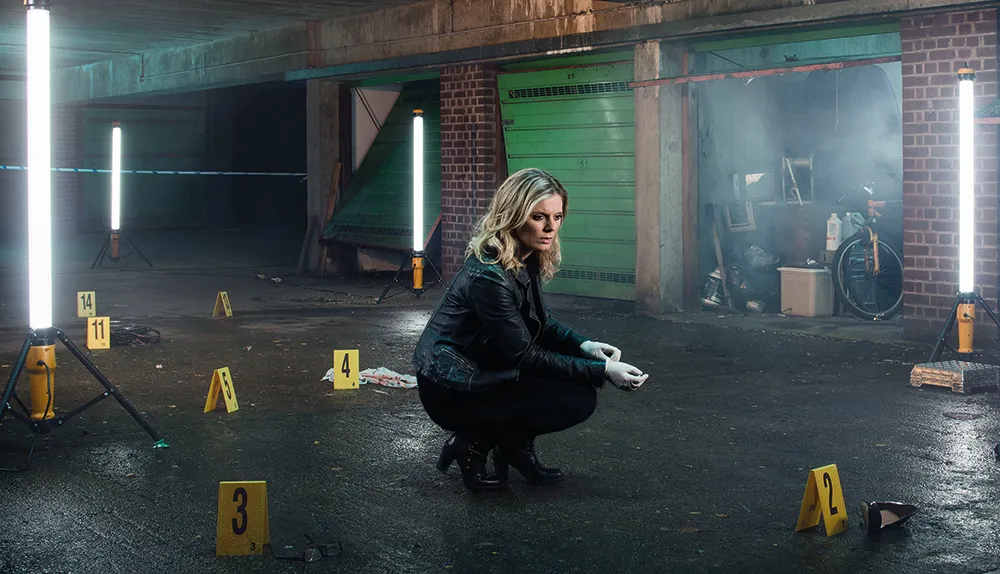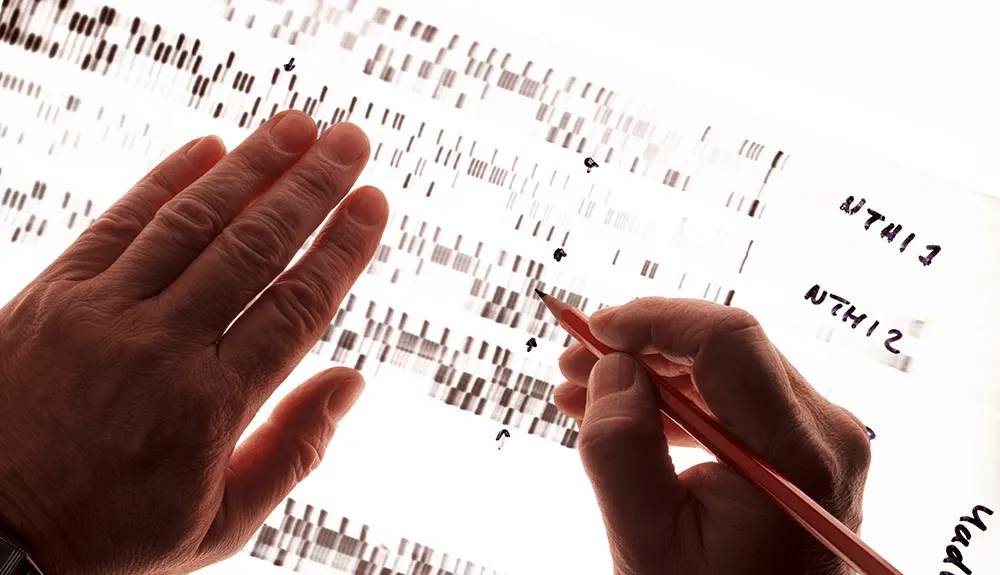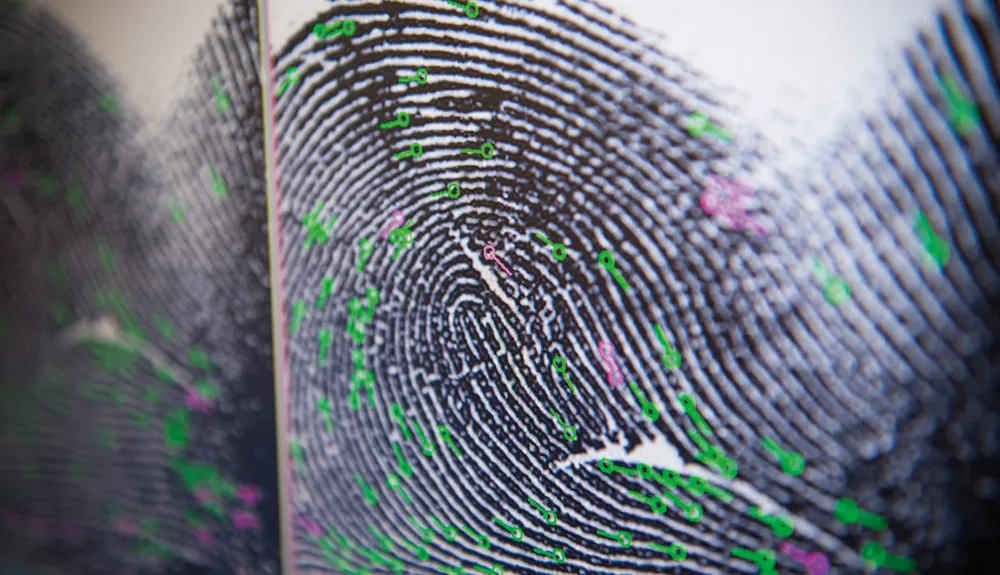What is forensic science?
Any scientific process used as part of a criminal investigation is considered forensic science. This spans both the grim, grisly procedures of the autopsy room and the cutting-edge analysis of a crime scene.
But it also encompasses the less glamorous, painstaking lab work of DNA profiling, fingerprint analysis and the uncovering of hidden digital files. There is even such a thing as forensic accountancy.
What techniques are used to solve crimes today?
The bulk of modern forensic work involves the analysis of DNA or fingerprints left at a crime scene. In murder cases, forensic autopsies help work out how a person died.
A range of more specialised and elaborate forensic techniques can be used to identify suspects in the most serious cases, such as tracking serial killers or terrorists.
Read more about DNA and forensic science:
- Forensic genealogy: how the police are using family trees to solve cold cases
- Crime writer Val McDermid on real-life forensic science
- Shakespeare's remarkable scientific accuracy
- What is DNA?
These methods include forensic ecology, where tiny traces of pollen or fungal spores can be used to tell where a suspect has been, or forensic entomology, where the presence of certain insects can help reveal how long a person has been dead.
As people spend more and more time on devices like smartphones and computers, so-called ‘digital forensics’ is playing an ever-greater role in criminal investigations, too.
The growth in this field of forensic science also reflects the fact that there are now over four million CCTV cameras in the UK.
Is forensic science anything like what we see on TV?
Rarely. According to forensic scientist Prof Sue Black, who has advised a number of crime writers throughout her career, “There is an element of truth in TV crime, but also an element of fantasy – the work is often long, slow, and laborious, and viewers quite rightly don’t want to see us doing our double-blind trials.”

Nathan Clarke, a professor of digital forensics and cyber security, says the depiction of tracking technology in spy movies, where security services miraculously enhance fuzzy images of suspects, is pure fiction.
“In reality, you need someone to sit there and watch hours of video,” he says.
How does DNA profiling work?
Although 99.9 per cent of our DNA is the same in every person, the remaining 0.01 per cent is different enough to distinguish one individual from another.
Forensic DNA profiling looks specifically at highly variable stretches of DNA called ‘variable number tandem repeats’ (VNTRs).
These are short sequences of genetic code that may occur tens or hundreds of times at specific points in a person’s DNA. VNTRs are often located in parts of the human genome with little or no known function.
Mutations in the genetic code here will not cause abnormalities, and so over many generations these sections of our genome have become hugely varied.

And because unrelated people will almost certainly have different numbers of VNTRs in different places, they can be used to discriminate between two people.
DNA found at a crime scene is processed so that these sections can be compared to those from a sample swabbed from a suspect, or compared to a huge number of DNA profiles held on police databases.
As well as helping to identify suspects, DNA profiling has helped prove the innocence of people incorrectly convicted, in some cases decades after the crime, and is often used to help identify victims, especially where people have been killed in large numbers or when their remains are badly damaged.
What’s the smallest amount of DNA from which a suspect or victim can be identified?
As technology advances, scientists can process smaller and smaller samples to develop a DNA profile.
Modern techniques can ‘amplify’ tiny amounts of DNA from minute traces of any material that contains fragments of tissue or cells, such as blood, semen, saliva, urine, faeces, hair, teeth or bone.
‘Low-level’ or ‘touch DNA’ can sometimes even be collected from a few skin cells left behind after a person has touched an object or victim.

With a full sample and the latest DNA profiling techniques, investigators are able to generate a ‘match probability’ of up to one in a quintillion (1018).
The chance of a random person in the population having that DNA profile is infinitesimally small.
If a suspect’s DNA is found at a crime scene, will it always lead to a conviction?
Not necessarily – there are all sorts of innocent reasons why a person’s DNA could be at a crime scene or on a body.
And even when DNA found at a crime scene is clearly that of the perpetrator, the police still need to find a match – if the murderer is not already a suspect, and their DNA profile is not on file, the evidence is effectively useless. However, in such cases a person’s own family can land them in it.
A serial killer known as the Grim Sleeper, who killed at least 10 people in Los Angeles between 1985 and 2007, eluded police for decades, despite them having a sample of his DNA. The culprit was finally apprehended when his son was arrested for weapons offences.
The son gave a regulation DNA sample, which partially matched the DNA profile found at all of the Grim Sleeper crime scenes, which led the police to investigate his relatives. Police posed as waiters to get the father’s DNA from a pizza slice, and found that it matched the crime scene DNA. He was arrested in 2010.
Can DNA evidence be faked?
Although DNA profiling is an excellent way to distinguish between individuals, it is still not immune to falsification, errors or manipulation.
In 1992, a doctor and rapist called John Schneeberger evaded justice by injecting other people’s blood into his arm just before his DNA was sampled by police. He was found guilty when forced to take another test years later.
It’s also possible, although extremely rare, for a person to be a ‘genetic chimera’, meaning that they have cells in their body with different DNA from the rest of them.
Why do forensic scientists still use fingerprinting?
With fingerprints, police can often use their own in-house specialists rather than call on external forensic scientists. The digitization of fingerprint records means a photograph of a fingermark can be sent from a crime scene and compared to a database almost in real time.
According to the Fingerprint Society, fingerprints remain the number one ID metric for crime scenes in the UK, accounting for the identification of well over 100,000 suspects in 2012.

Prints can also help indicate what someone was doing or how they entered a building – for example, if they are found leading up to a broken window or in a grip figuration on a weapon. And unlike DNA, it’s hard to plant a fingerprint at a crime scene.
How accurate is fingerprinting?
Fingerprints may be considered an ‘older’ forensic technique, having first been used in the 1890s, but the technology behind them is continuously being improved. As well as the well-known method of ‘dusting’ for fingerprints at the scene, forensics teams can also use chemical reagents and lasers to reveal extremely faint prints.
Even more sensitive tools can be deployed if objects are taken back to the lab. One method involves gold or silver particles being placed with a sample in a vacuum; the metal will settle on the faintest of marks.
Is everyone’s fingerprint really unique?

The underlying patterns of ridges on people’s digits are determined genetically, but the way individual ridges divide and break is dependent on conditions in the womb and the movement of the developing foetus.
Even the fingerprints of identical twins will be different, while their DNA will be the same.
What else might police look for at a crime scene?
Criminals often wear gloves while committing premeditated crimes, but they can’t float in and out of the crime scene, so footprints can be crucial.
While footwear can’t definitively identify an individual, knowing the exact model of shoe the perpetrator wore is still very useful intelligence when looking for a suspect.
In more serious crimes, forensic ecologists will look for traces of biological material that can link a suspect to a certain area, such as the type of woodland where a body has been found. Pollen and fungal spores are especially important as they are picked up easily but not easily shed, even from clothing and footwear that’s been washed.
But suspects are likely to have walked through many types of soil, mud, or vegetation before and after being at a crime scene. It all adds up to a huge headache for those trying to analyse and compare all the biological material found on the suspect.

The rarer the pollen or spore that forensics can match, the more credible the case. A good example is also the first ever example of forensic ecology.
In 1959, a man was murdered while travelling down the river Danube in Austria, but a body had not been found. Mud on the suspect’s shoes contained a type of pollen from ancient hickory trees.
Scientists concluded this could only have come from vegetation growing on exposed Miocene-age rocks, and the only place such soil had developed was a small section of the river 20km north of Vienna.
Presented with this theory, the suspect confessed and took police to the body – exactly where the scientists had predicted.
Other techniques often seen on TV, such as blood spatter and ballistics analysis, may give detectives an idea of what happened at a crime scene, but rarely help find the perpetrator.
What can forensics teams learn from human remains?
In the first 72 hours after death, a pathologist is usually able to provide a reasonably accurate determination of the time and cause of death.
If a person has been dead for longer, forensic entomologists may be called on to estimate the time of death, based on the number and type of insects feeding on the corpse. This method can be used to determine a period of hours, weeks or even years since death.
Read more about DNA and forensic science:
- Forensic science: What we still don't know
- DNA: A timeline of discoveries
- How to use DNA databases to catch the perpetrator of a crime
Blowflies are almost always the first insects to arrive and lay eggs on a corpse, as they are mobile, common and able to smell death from up to 10km away. Eventually other families of insects are attracted to the body, such as beetles.
For more heavily decomposed or damaged remains, forensic dentists can match remnants of teeth to known dental records, or even use what they find to draw conclusions about the victim’s age, size, gender, race and socioeconomic status.
What is currently being developed at the cutting edge of forensic science?
Forensic scientists can use anything to link a suspect to a crime scene, as long as they can prove the samples are unlikely to match by chance.
In the US, scientists have looked at the atomic structure of fragments of glass to prove it was from the same sheet of glass as that found broken at a crime scene.
Pioneering techniques that mix digital forensics with anatomy are also now being used to identify people from small areas of their body seen in photos or videos.
Features such as vein patternation or knuckle marks can identify suspects from images showing only small areas of their hands or arms. Grimly, this is likely to be used in cases involving sexual abuse.
As our understanding of DNA improves, we may one day be able to create a photofit-style image of a suspect solely from DNA evidence.
However, such ‘DNA phenotyping’ is not yet accurate enough, and can’t predict many aspects of how a person looks, such as whether they have a beard.
Anatomy of a modern crime scene
Fingerprints
Prints can be recovered from surfaces. Their position helps detectives sequence events.
Insects
Insects on the body can help to determine when the victim died. Blowflies and then maggots arrive first, followed by beetles.
Saliva
There may be visible bodily fluids, but DNA can be collected from less obvious sources such as a drinking glass.
Vegetation
Pollen and spores from plants and fungi can stick to clothes or car tyres, linking suspects to a precise location.
Footmarks
Forensics can recover a footmark that’s almost invisible to the eye.
- This article first appeared in issue 293 ofBBC Science Focus–find out how to subscribe here